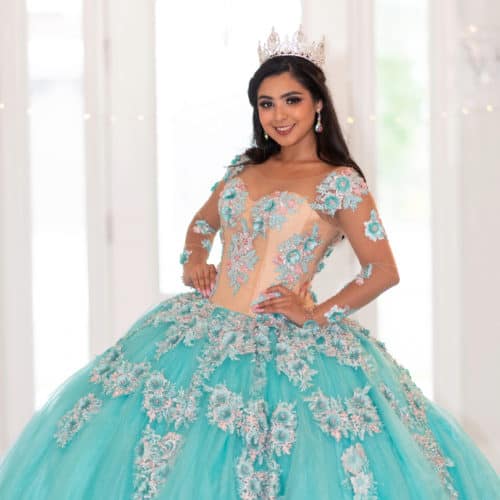In Latin American culture, few celebrations rival the grandeur and significance of a Quinceañera.
This age-old tradition is steeped in elegance and celebration that marks a young girl’s transition from childhood to womanhood.
At the heart of this lavish fiesta lies a symbol of grace and style that captivates the imagination of many—the Quinceañera dress.
Why is a quince dress important, you may wonder?
A Quinceañera dress is not just a garment. It’s a representation of a young girl’s journey towards maturity and a reflection of her cultural heritage.
Join us on a journey to explore the enchanting world of Quinceañera dresses. Discover the significance that makes them an integral part of this cherished tradition.
Key Takeaway
- A Quinceañera marks a girl’s 15th birthday and transition to womanhood. The dress symbolizes her maturity and cultural heritage.
- Quinceañera dresses have evolved from simple to lavish with tulle, lace, and embellishments.
- They represent the blend of tradition and modern culture for Latin American girls.
- Expensive designer Quinceañera dresses can cost up to $10,000. Top brands highlighted include Oscar de la Renta, Mori Lee, and House of Wu.
- Factors like premium materials, custom design, accessories, and embellishments drive up the costs.
- When choosing a dress, consider your budget, body type, style preferences, color, quality, details, comfort, and venue.
- The Quinceañera dress crowns the occasion, representing the girl’s transition into womanhood.
A Quinceañera: A Day of Dreams
To understand why these dresses are so culturally important, we must first delve into the heart of the celebration itself.
A Quinceañera is a significant celebration in many Latin American countries, like Mexico, Central America, and parts of the United States.
It’s similar to a debutante ball but with a special twist: it marks a girl’s fifteenth birthday and her transition to womanhood.
This event symbolizes her growing up and taking on new responsibilities as a young woman in her family and society.
It’s a joyful day filled with festivities, symbolizing a bright future.
Families often plan for this day well in advance. It’s a unique celebration of love, tradition, and cultural importance.
Fun Fact: The most extravagant quinceañera on record cost $6 million for Maya Henry, the daughter of attorney Thomas J. Henry, in 2016.
The lavish event featured star performances from Nick Jonas and Pitbull.
She wore two dresses worth $20,000 each and invited celebrity make-up artist Patrick Ta.
While over-the-top, most quinceañeras focus on family and culture rather than opulence.
The Importance of Quinceañera Dresses
At the core of this celebration, the Quinceañera dress serves as a symbol of beauty, grace, and tradition.
Over time, these dresses have changed to match evolving fashions and cultural influences, but their significance remains constant.
Cultural Beginnings
The Quinceañera tradition traces its roots to indigenous Mesoamerican cultures.
Before the Spanish arrived, indigenous communities marked the transition from childhood to womanhood with elaborate ceremonies, including clothing changes.
With the arrival of the Spanish, this tradition saw the introduction of a formal church blessing.
This has become an integral part of today’s Quinceañera ceremony.
Style Evolution
Quinceañera dresses have adapted to shifting fashion trends and influences.
In earlier times, Quinceañera dresses were characterized by simplicity, reflecting the modesty of their era.
However, as fashion trends evolved, so did these dresses.
Modern Quinceañera dresses are characterized by their opulence and elegance, featuring layers of tulle, lace, intricate embroidery, and various embellishments.
More about this later on!
Cultural Significance
The Quinceañera dress plays a crucial role in the celebration as it visually represents the young girl’s transformation.
The dress often combines traditional, religious, and contemporary elements, reflecting the cultural diversity of Latin America.
These dresses reflect the Quinceañera’s heritage and connect to her roots.
Whether a traditional white gown symbolizing purity or a colorful dress reflecting cultural influences, the Quinceañera dress carries the weight of tradition while embracing the spirit of the present.
Most Expensive Quinceanera Dresses
Now that we’ve explained its cultural importance, let’s dive into the most expensive Quinceañera dresses.
Oscar de la Renta
Tulle-Draped Sweetheart Gown
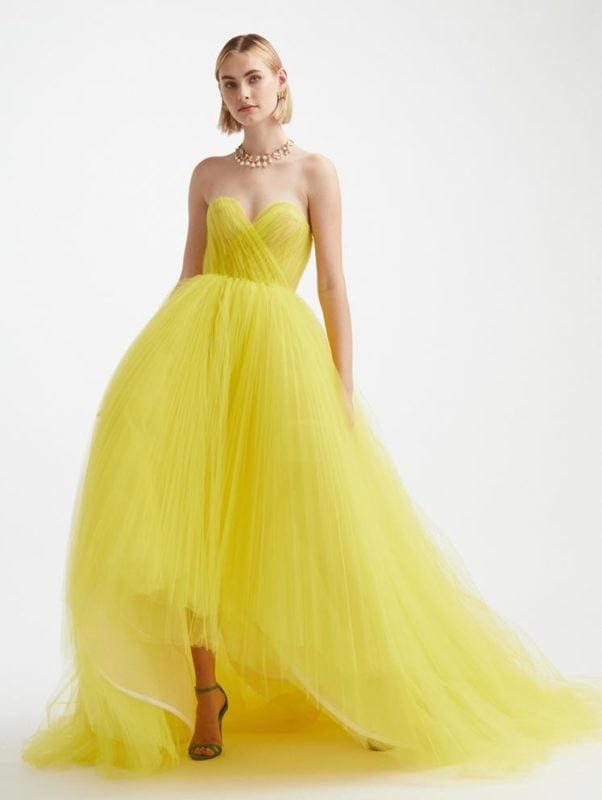
Source: oscardelarenta.com
Oscar de la Renta’s Tulle Sweetheart Gown epitomizes the opulence of the most expensive quinceañera dresses.
This traditional full ball gown, crafted from citrine tulle, features a high-low hem and a sweetheart neckline, making it a lavish choice for this special occasion.
The floor-sweeping train adds an extra touch of grandeur, ensuring a dramatic entrance. Composed of 100% nylon, it combines luxury with style.
Price: $9,890.00
Mori Lee
Three-Dimensional Floral Lace Quinceañera Dress with Floral Skirt
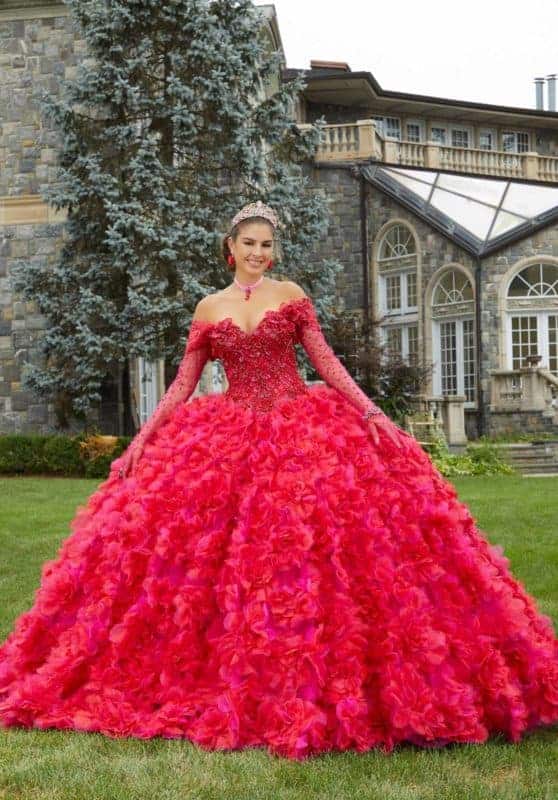
Source: morilee.com
Mori Lee’s Three-Dimensional Floral Lace Quinceañera Dress is a stunning and romantic ball gown designed for a special quinceañera celebration.
The sweetheart bodice is adorned with beautiful rhinestone and crystal-beaded 3D floral appliqués, creating an enchanting look.
The gown’s skirt is made of dramatic sparkle tulle with floral accents, adding a touch of magic.
You can choose to wear it with or without the off-the-shoulder sleeves, and it also includes matching beaded tulle gloves for a customized style.
With a floor-length design, basque waist, and tulle fabric, this quince dress combines elegance and opulence, ensuring a memorable presence on your important day.
Price: $2,999.00
Floral Glitter and Feather Quinceañera Dress
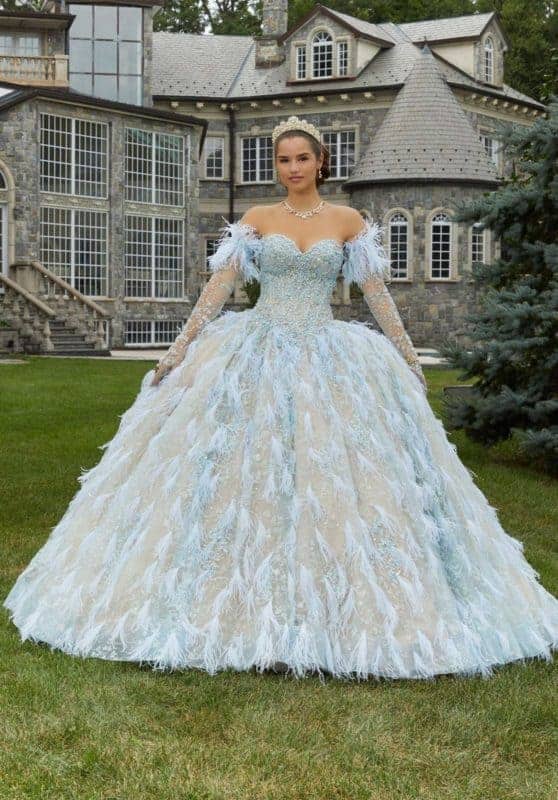
Source: morilee.com
The Mori Lee Floral Glitter and Feather Quinceañera Dress is a stunning ball gown.
It features a rhinestone and crystal-beaded bodice with a sweetheart neckline, transitioning into a glittery floral skirt adorned with feathers.
This floor-length gown has a strapless, off-the-shoulder style and a basque waist, providing an elegant and regal look.
Made from tulle, it’s perfect for a special quinceañera celebration. It guarantees the birthday girl feels like a princess on her big day.
Price: $2,999.00
Off-Shoulder Embroidered Ballgown
The Vizcaya by Morilee Off-Shoulder Embroidered Ballgown is a stunning pick for your special occasion.
It has an off the shoulder neckline, a mid-open back with a lace-up closure, and a beaded, embroidered bodice that flows to a floor-length hem.
Made of satin and tulle, it’s luxurious and elegant. The ball gown style highlights your waist, giving a regal feel.
With various color choices, this gown guarantees a memorable presence.
Elevate your look and find the perfect ball gown for your event.
Price: $2,308.00
House of Wu
Detachable Train V-Neck Sweet 16 Gown – 26040C
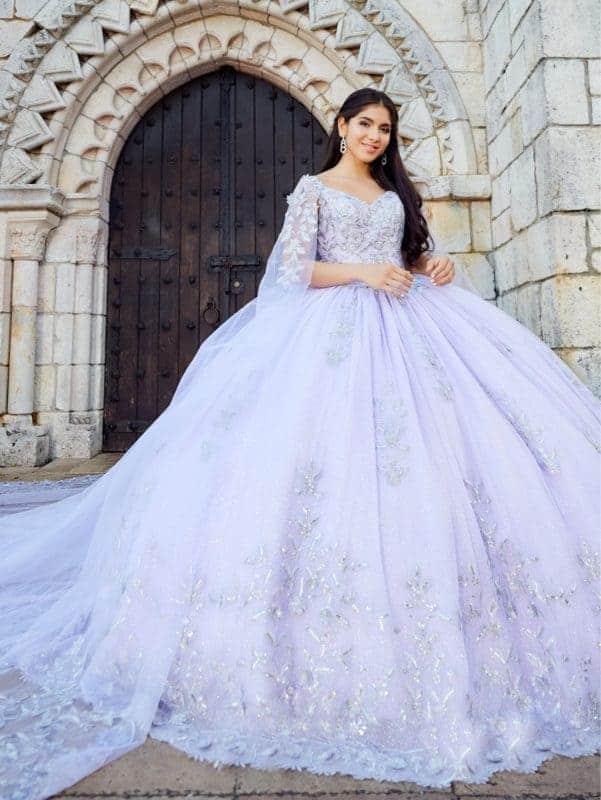
Source: houseofwu.com
This is a lovely lilac silver quinceañera dress. It’s made from diamond tulle with beautiful metallic lace appliques, adding a touch of elegance.
The bodice is adorned with intricate details and has a stylish V-neckline, spaghetti straps, and a lace-up back for a perfect fit.
The quince dress has a basque waist that flows into a full ball skirt with a royal train.
Additionally, it comes with a long cape train featuring matching appliques, which you can remove for a different look.
This gown is versatile and luxurious, perfect for your quinceanera.
Price: $2,438.00
Cape Train Removable Skirt Quinceanera Dress – 26020C
The Cape Train Removable Skirt Quinceanera Dress is a striking black and silver gown in diamond tulle.
It features a corset top with a strapless sweetheart neckline and beaded floral appliques.
The dress has a unique high-low skirt with a detachable ball skirt and comes with a royal train.
It includes a lace-up back and a long cape train with a hood. It’s also available without the cape as Style 26020.
Price: $1,978.00
Detachable Train Floral Sequin Quinceanera Gown – 26027T
This is a captivating sky blue quinceañera dress. It’s made of sparkling tulle with intricate sequin embroidery and 3D flowers, giving it a touch of elegance.
The basque waist ballgown features an off-the-shoulder sweetheart neckline, a lace-up back, and a removable cathedral train for a grand entrance.
If you prefer a different style, it’s also available without the detachable train as Style 26027.
Price: $1,898.00
Puff Sleeve Cape Quinceanera Dress – 26075
This is a fantastic choice for your special day.
This beautiful quinceañera ball gown has a strapless corset bodice with sequin lace appliques and a lace-up back for a personalized fit.
The A-line skirt is adorned with lace and bow detail, and it comes with a train.
What’s great about this quince dress is that it comes with a removable cape and long puff sleeves, allowing you to create different looks for your special occasion.
It’s a dress designed to make you stand out and shine.
Price: $1,790.00
Ruffled Charro Quinceanera Dress – 24096
This Puff Sleeves Quinceañera Dress is a charro ball gown by House of Wu LA Glitter that will leave you breathless.
This striking off-the-shoulder ball gown features a sweetheart bodice with corset boning and stunning gold embroidery details.
The A-line ruffled skirt is adorned with cascades of organza and tulle, adding volume and drama to your look.
To complete this enchanting ensemble, there’s a corset and bow detail in the back.
Available in colors Ivory/Sage Green and Ivory/Red, this dress is a true showstopper from the House of Wu LA Glitter’s Designers Collection for Spring 2022.
Perfect for making a statement on your special day.
Price: $1,640.00
Crystal Beaded Rosette Ruffle Ballgown – 26800
This striking gown is perfect for your coming-of-age celebration.
It features a strapless sweetheart bodice adorned with beautiful sparkles and a lace-up back for a custom fit.
The magnificent skirt is made of beaded tulle and organza ruffles in a rosette pattern, creating a lavish ballgown that sweeps the floor.
Radiate regal elegance in this stunning design and explore more Quinceanera dresses to make your day truly special.
Price: $1,320.00
Princesa by Ariana Vara
Ruffled Sweetheart Ball Gown – PR22027
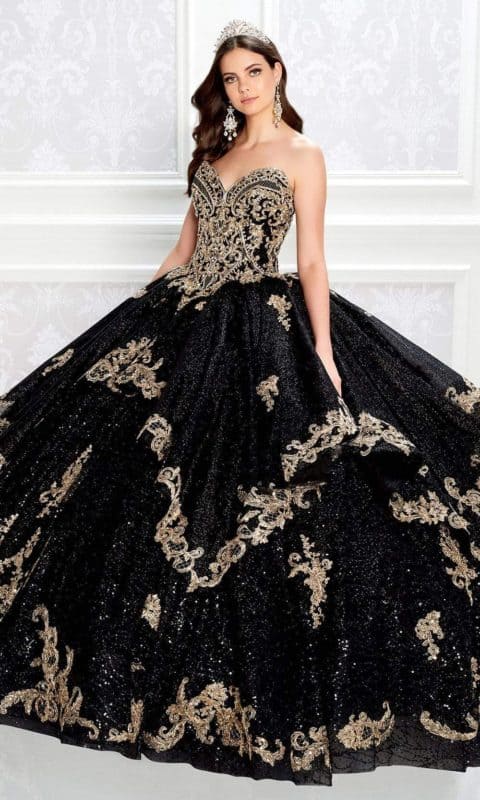
Source: arianavara.com
The Ruffled Sweetheart Ball Gown by Princesa from Ariana Vara (style PR22027) is your stunning entrance ticket.
This strapless ball gown features a sweetheart neckline, a basque waist, and a corset back for a perfect fit.
The bodice is decorated with lace and beads that continue down to the ruffled skirts, ending with a sweep train.
To complete the princess look, the set includes a jacket and separate sleeves.
This creation by Princesa from Ariana Vara is absolutely captivating and perfect for your special occasion.
You can find more Quinceanera Dresses for additional options.
Price: $1,469.00
3D Florals and Cape Ball Gown – PR12262
The 3D Florals and Cape Ball Gown from Princesa by Ariana Vara, style PR12262, is a mesmerizing choice for a special night.
It features an illusion halter neckline and a sheer, floral-adorned bodice with beads.
A detachable sheer cape drapes over the back, and the full ball gown skirt ends with a sweeping train.
Whether your style is modern or classic, this gown exudes poise and elegance for your occasion.
Explore more Sweet 16 Dresses and Floral Dresses for Women to find your perfect look.
Price: $1,469.00
Short Sleeve Ball Gown – PR22025
The Short Sleeve Ball Gown from Princesa by Ariana Vara is a show-stopper.
Made with tulle and lace appliques, this ball gown features a Queen Anne neckline, a beaded bodice, a basque waist, a corset back with a keyhole detail, and a sweep train.
It’s a truly glamorous creation by Princesa by Ariana Vara that’s perfect for your special occasion.
Price: $1,469.00
Factors Contributing to the Expense
The most extravagant Quinceanera dresses can cost tens of thousands of dollars due to premium materials, meticulous construction techniques, and opulent embellishments.
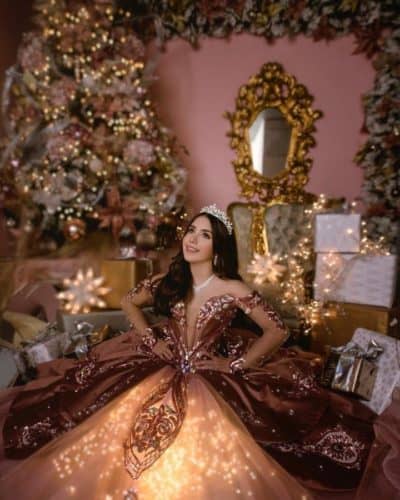
Credits: @shopadasa / Pinterest
Many factors contribute to their high price tag. These include:
- High-End Materials – Using premium fabrics like silk, satin, and lace drives up costs. Intricate embellishments with crystals, sequins, and beads also add to the price tag.
- Custom Design – Made-to-order dresses designed specifically for each Quinceañera with unique personal touches are more expensive than off-the-rack.
- Complex Construction – Gowns with voluminous skirts, fitted bodices, and structural elements require more labor and expertise to construct, increasing costs.
- Brand Name – Having a dress by a renowned designer brand like Carolina Herrera or Oscar de la Renta commands a premium price. Their reputation for quality and style increases demand.
- Accessories – Adding luxury accessories like tiaras, jewelry, gloves, and designer shoes elevates the look and price point. These meticulous details complete the ensemble.
- Fabrication – Many expensive dresses use fabrics like silk organza, satin, and Chantilly lace, which are more costly than synthetics.
- Embellishments – Elaborate embellishments like hand-sewn crystals and pearls, intricate beading, and embroidery drive up labor and material expenses.
- Construction – Structural elements like corset ties, bustles, petticoats, and hoop skirts require expertise and add cost.
Overall, from the fabric to final embellishments, each choice made in constructing the most expensive Quinceanera dresses contributes to their elevated price and luxurious aesthetic.
The result is a breathtaking work of art celebrating this milestone event.
Tips for Choosing Quinceanera Dresses
Choosing the perfect Quinceanera dress is a significant part of this important celebration.
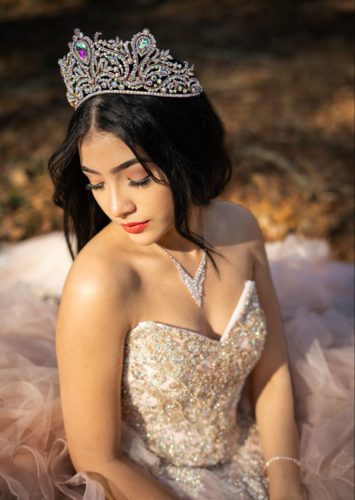
Credits: @RJPhotographer / Pinterest
Here are some tips to help you select the best dress for your special day:
- Plan Early: Start looking for your quince dress several months in advance to allow time for fittings and alterations.
- Set a Budget: Determine your budget before you begin shopping. This will help you narrow down your options and avoid overspending.
- Consider Your Body Shape: Choose a dress that complements your body shape. Different styles flatter different figures, so try on various silhouettes to find the one that suits you best.
- Explore Different Styles: Quince dresses come in various styles, from classic ball gowns to modern and unique designs. Explore your options to find a style that resonates with your personality and preferences.
- Think About the Color: Select a color that complements your skin tone and personal taste. Pastels, bold colors, and soft shades are popular choices.
- Quality Matters: Invest in high-quality fabrics and materials. Quality quinceanera dresses often look and feel better and can be more comfortable.
- Pay Attention to Detail: Consider the dress’s details, such as embroidery, lace, sequins, or beading. These embellishments can add a touch of sophistication to your gown.
- Comfort is Key: Ensure the dress is comfortable to wear, especially if it will be a long celebration. Comfortable straps, an appropriate neckline, and a well-fitted bodice are essential.
- Don’t Forget About the Venue: Keep the venue in mind when choosing your dress. A grand ballroom may call for a more formal gown, while an outdoor celebration may require a lighter and more casual style.
- Consult with Family and Friends: Get input from your loved ones, but remember that the final decision should be yours. It’s your day, and your dress should reflect your personal style and preferences.
- Be Open to Alterations: Be prepared for some alterations to ensure a perfect fit. Find a skilled seamstress who specializes in formal wear.
- Plan Your Accessories: Consider how your quince dress will pair with accessories like tiaras, jewelry, and shoes. Make sure they complement your dress.
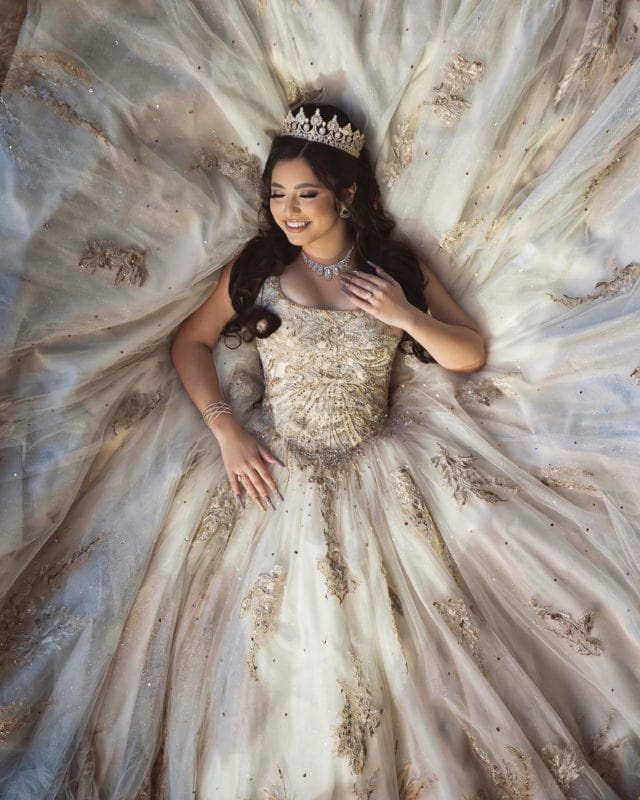
Credits: @jnogales_photography / Instagram
Choosing your Quinceañera dress is a significant step in celebrating your transition to womanhood.
With careful planning and consideration, you’ll find the perfect dress that makes you feel like a princess on your special day.
Conclusion
In Quinceañera celebrations, the allure of the most expensive quince dresses is undeniable.
These exquisite gowns, crafted with opulent materials and intricate designs and often carrying the prestige of renowned designers, create a captivating blend of luxury, tradition, and style.
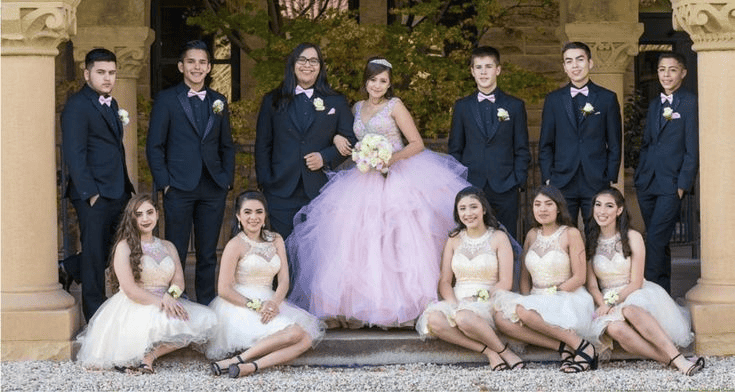
Credits: @quinceaneraexpo / Pinterest
Each dress tells a unique story, symbolizing the transition from girlhood to womanhood with grace and elegance.
As these young girls enter the spotlight, these quinceanera dresses are their crowning glory.
Because of this, the Quinceañera is a truly unforgettable and regal occasion.

